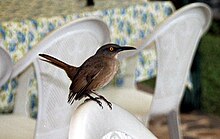| Tremblers | |
|---|---|
 | |
| Brown trembler (Cinclocerthia ruficauda) | |
| Scientific classification | |
| Domain: | Eukaryota |
| Kingdom: | Animalia |
| Phylum: | Chordata |
| Class: | Aves |
| Order: | Passeriformes |
| Family: | Mimidae |
| Genus: | Cinclocerthia G.R. Gray, 1840 |
| Type species | |
| Stenorhynchus ruficauda [1] Gould, 1836 | |
| Species | |
(but see text) | |
| Synonyms | |
BuleitesGistl, 1848 Contents | |
Tremblers (Cinclocerthia) are a genus of perching birds in the family Mimidae that are endemic to the Lesser Antilles. They are medium-small, mostly brown or grey birds with long beaks and tails that typically are held cocked. Most recent authorities recognize two species in the genus, but some split each into two species, bringing it to four species:
- Grey trembler (Martinique trembler), Cinclocerthia (gutturalis) gutturalis
- Saint Lucia trembler, Cinclocerthia (gutturalis) macrorhyncha
- Brown trembler (Southern brown trembler), Cinclocerthia (ruficauda) ruficauda
- Northern brown trembler, Cinclocerthia (ruficauda) tremula
Among other living birds, they are apparently most closely related to the pearly-eyed thrasher. [2]
Their common name comes from their peculiar behavior: if excited, they will show a much more exaggerated version of the wing-flicking also seen in other mimids such as the northern mockingbirds. The tremblers do not just flick their wings, but shake their entire bodies in a trembling motion.